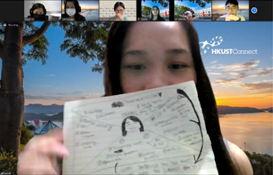Embracing the Power of Visuals to Communicate Learning Experience
Professional staff: Ms Miranda Man, Ms Helen Wong, Ms Beryl Lam, Ms Eva Shek & Ms. Rufina Wong
Department: Dean of Students’ Office, HKUST
Email: samiranda@ust.hk
Virtual visual facilitation was introduced into HKUST in the 2020 summer co-creation program “Project # U2.0”. Students and staff were guided to use basic visual elements, icons and templates for idea generation in three intensive Virtual Visual Facilitation LAB training sessions. To further harness the power of visuals, a Train-the-Trainer program was arranged to enable staff to deliver the visual facilitation workshops and to integrate the different sections into their own programs or advising with students. HKUST Connect team (1) initiated “CMe”, a visual that facilitates self-exploration and captures students’ experience in a community project, (2) developed visual thinking workshops “You Can Draw – Develop your visual thinking to communicate ideas”, and (3) incorporated visual templates in different programs and activities for reflection and communication.
Given these initiatives started during the pandemic, sessions were held online initially. To replicate the original setting, staff set up their top-down camera at home to capture the drawing on paper, whereas students could choose the media (i.e. paper-and-pen or e-canvas) they felt comfortable. The team selected visual facilitation components and templates for each session to fit the activities’ progress and needs. Ms Miranda Man highlighted that visual facilitation is more than just drawing pictures but more of the process of thinking, developing and communicating ideas. It requires listening skills to capture the key points, and thinking skills to conceptualize, organize the main points and transform them into visuals. Hence, the team emphasized the process and message delivered and reinforced students’ ability to create instead of esthetics throughout the sessions.
The response is positive, given that most students are open to this visual option. Students reported feeling more relaxed and engaged compared to writing reflective essays. They were willing to switch on cameras and present their drawing to others in the online sessions. Students were able to modify the original templates, personalize their visuals and reflect deeply. Besides, they feedbacked that learning visual facilitation promoted creativity because they were stimulated by the creation process and others’ artworks.
Ms Man remarked that visual facilitation, similar to other engagement tools, has its limitations and issues to address. For instance, pictures may not be able to convey a precise meaning, therefore extra elaboration might be required. Moreover, both students and staff take time to adopt this thinking model and develop their drawing capacity. In the future, the HKUST Connect team will continue these initiatives. However, face-to-face mode is preferred because students can better concentrate and interact with others within the same space. On top of that, the team would like to enrich their visual vocabulary with students involved and extend its usage to consultations and rapport-building activities.
Sharing from Ms Miranda Man and Ms Beryl Lam in previous workshop: https://www.vtl-beyond-classrooms.com/news-3/explore-and-enhance-new-extra-curricular-learning-under-virtual-mode











